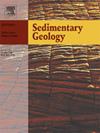Stratigraphic architecture of a multi-sourced, Deepwater lobe complex (early Permian, Paraná basin, Brazil)
IF 2.9
2区 地球科学
Q1 GEOLOGY
引用次数: 0
Abstract
The Rio Segredo Member of the Taciba Formation (Paraná Basin, Brazil) represents a unique example of a multi-sourced turbidite lobe complex, providing valuable insights into the stratigraphic architecture and depositional processes of delta-fed submarine ramp systems. This study investigates the lobe complex, which extends over 120 km and reaches a thickness of up to 40 m, with a focus on bed type distribution, facies associations, and stratigraphic architecture. Through the analysis of 16 measured sections and detailed facies analysis, 14 distinct bed types were identified, including turbidites (TBDs), hybrid event beds (HEBs), and slump and blocky flow deposits (MTDs). These beds are organized into four sub-environments: lobe axis, lobe off-axis, lobe fringe, and distal lobe fringe, reflecting a compensational stacking pattern with lobe centroids shifting southward by an average of 25 km. Paleocurrent data indicates predominant flow directions to the northwest (320°) and southwest (235°), supporting the interpretation of a multi-sourced system. The lobe complex is interpreted as a delta-fed submarine ramp, with deposition driven by delta-front instabilities and hyperpycnal flows via conduits connected to prograding delta. Hybrid event beds, which are common in the basal sandy portion of the succession, are linked to substrate erosion and interactions with small-scale morphological highs, highlighting the influence of paleophysiography on flow dynamics. This study enhances the understanding of multi-sourced turbidite systems and provides a framework for identifying similar systems in other basins. The findings underscore the importance of autogenic controls, such as lobe avulsion and topographic compensation, in shaping the stratigraphic architecture of delta-fed turbidite systems.
巴西帕拉纳盆地早二叠世深水多源叶状杂岩的地层构型
巴西帕拉南盆地Taciba组里约热内卢Segredo段是多源浊积叶状杂岩的一个独特例子,为三角洲海底斜坡系统的地层结构和沉积过程提供了有价值的见解。本研究对叶状复合体进行了研究,该复合体延伸超过120公里,厚度达40米,重点研究了床型分布、相组合和地层结构。通过对16个实测剖面的分析和详细的相分析,确定了14种不同的层型,包括浊积岩(TBDs)、混合事件层(HEBs)、滑塌和块状流沉积(MTDs)。这些地层被划分为4个亚环境:叶轴环境、叶离轴环境、叶边缘环境和远叶边缘环境,反映出叶中心向南移动平均25 km的补偿叠加格局。古海流资料显示,主要流向为西北(320°)和西南(235°),支持多源系统的解释。叶状复合体被解释为三角洲供给的海底斜坡,其沉积是由三角洲前缘的不稳定性和连接到推进三角洲的导管的超旋流驱动的。混合事件层在演替的基底砂质部分中很常见,它与基底侵蚀以及与小尺度形态高点的相互作用有关,突出了古地貌对流动动力学的影响。该研究增强了对多源浊积岩系统的认识,并为识别其他盆地的类似系统提供了框架。这些发现强调了自生控制的重要性,如裂片撕裂和地形补偿,在形成三角洲浊积体系的地层结构中。
本文章由计算机程序翻译,如有差异,请以英文原文为准。
求助全文
约1分钟内获得全文
求助全文
来源期刊

Sedimentary Geology
地学-地质学
CiteScore
5.10
自引率
7.10%
发文量
133
审稿时长
32 days
期刊介绍:
Sedimentary Geology is a journal that rapidly publishes high quality, original research and review papers that cover all aspects of sediments and sedimentary rocks at all spatial and temporal scales. Submitted papers must make a significant contribution to the field of study and must place the research in a broad context, so that it is of interest to the diverse, international readership of the journal. Papers that are largely descriptive in nature, of limited scope or local geographical significance, or based on limited data will not be considered for publication.
 求助内容:
求助内容: 应助结果提醒方式:
应助结果提醒方式:


